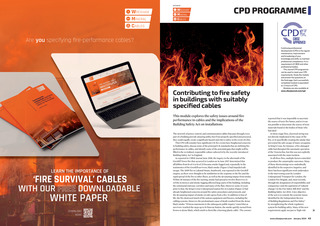


SPONSOR CPD PROGRAMME Contributing to fire safety in buildings with suitably specified cables This module explores the safety issues around fire performance in cables and the implications of the Building Safety Act on installations The network of power, control, and communication cables that pass through every part of a building provide amazing utility, but if not properly specified and procured, they could equally create a significant hazard and risk to safety in the event of a fire. This CPD will consider how significant UK fire events have heightened concerns in building safety, discuss some of the principal UK standards that are defining fire performance in cables, and identify some of the potential gaps that might well be filled in the revitalised, responsible culture ushered in by the recently introduced Building Safety Act1 in England. As reported in CIBSE Journal June 2018, the inquiry in the aftermath of the Grenfell Tower fire that occurred in London on 14 June 2017 determined that all lobbies from level 4 to level 23 became smoke-logged and, repeatedly in the testimonies of the Grenfell survivors, black smoke (Figure 1) had impeded safe escape. The 2009 fire in Lakanal House, Southwark, was reported to the Grenfell enquiry, as there were thought to be similarities in the response to the fire and the rapid spread of the fire to other floors, as well as the devastating impact from smoke. Within 30 minutes of the fire starting, smoke had spread to involve floors 6 to 12 (of the 14 storeys) and smoke-logging affected large parts of the building, including the communal staircase, corridors and many of the flats. However, some 22 years prior to that, the Kings Cross Underground station fire in London (Figure 2) had already heightened concerns around fire safety procedures and protocols, and the devastating impact of smoke on safe egress from a fire. In addition to loss of life, the fire destroyed much of the station equipment and fixtures, including the cabling systems. However, the predominant cause of death resulted from the dense black smoke.2 Witness statements in the subsequent public inquiry2 noted that as survivors reached the steps up to St Pancras Station, the smoke quickly turned from brown to dense black, which smelt to them like a burning plastic cable. The coroner Continuing professional development (CPD) is the regular maintenance, improvement and broadening of your knowledge and skills, to maintain professional competence. It is a requirement of CIBSE and other professional bodies. This Journal CPD programme can be used to meet your CPD requirements. Study the module and answer the questions on the final page. Each successfully completed module is equivalent to 1.5 hours of CPD. Modules are also available at www.cibsejournal.com/cpd reported that it was impossible to ascertain the source of toxic fire fumes, and so it was not possible to determine the source of toxic materials found in the bodies of those who had died.2 In these tragic fires, electrical wiring was not directly implicated in the cause of the fire, or in specifically creating the smoke that prevented the safe escape of many occupants. At Kings Cross, for instance, a fire-damaged cable had disrupted the automatic operation of the Victoria line, but this was not explicitly associated with the main incident. In all three fires, multiple factors coincided to produce the catastrophic outcomes. Many of these shortcomings were undoubtedly identified in the respective inquiries, and there has been significant work undertaken in the intervening years by London Underground/Transport for London, the London Fire Brigade, and, most recently, through the designation of responsibility and competence (and the aspiration of cultural change) in the Fire Safety Bill 20213 and the Building Safety Act 2022. A key objective of the acts is to remedy the systemic issues identified by the Independent Review of Building Regulations and Fire Safety4 by strengthening the whole regulatory system for building safety. Many of the new requirements apply not just to high-risk www.cibsejournal.com January 2024 43 CIBSE Jan 24 pp43-46 CPD Module 228 WMC.indd 43 21/12/2023 13:57